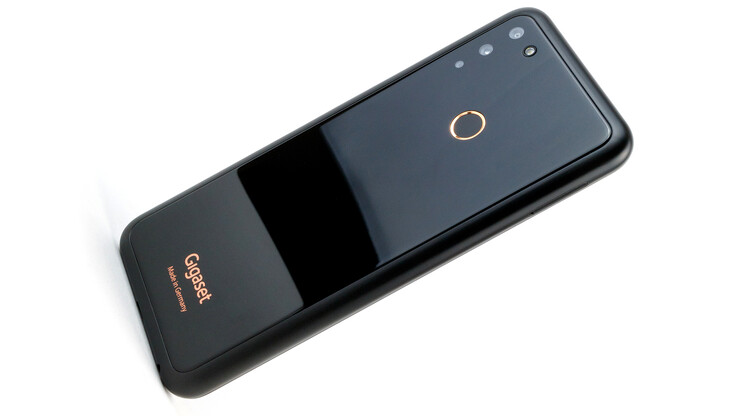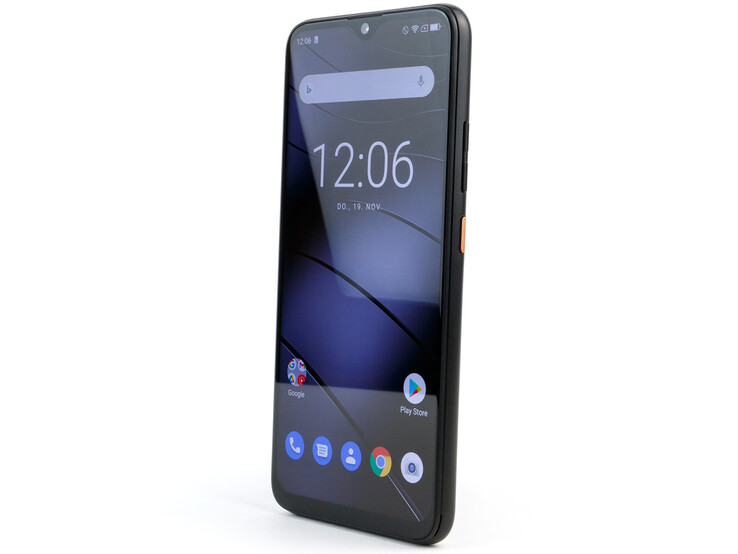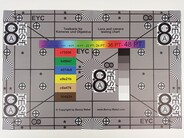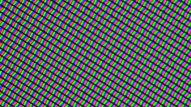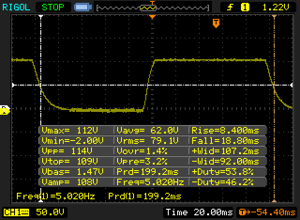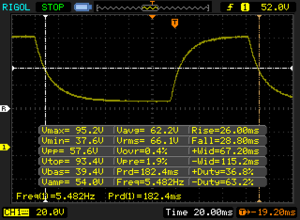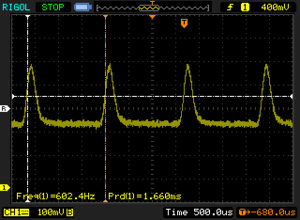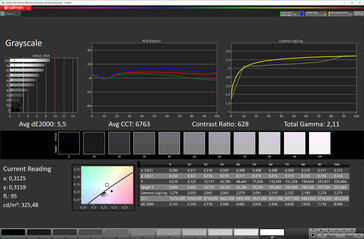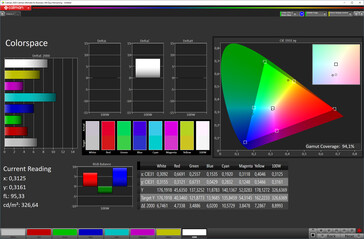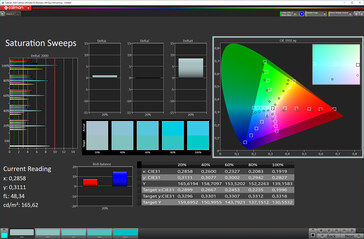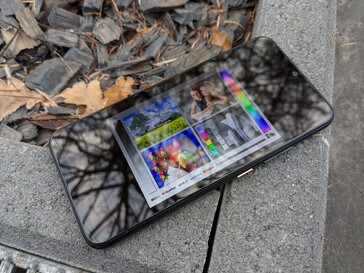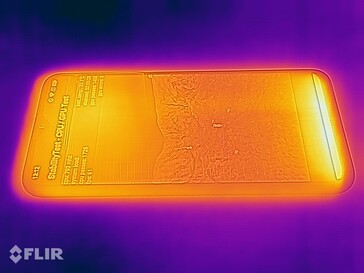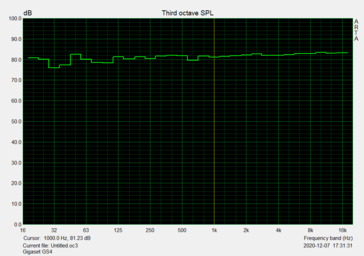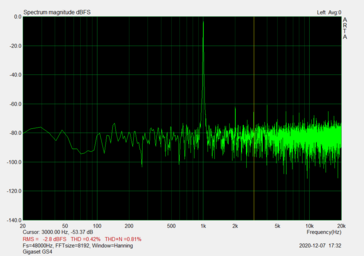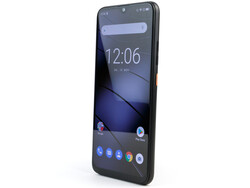Gigaset GS4 Review - No great cinema, but a good everyday smartphone
Possible competitors in comparison
Bewertung | Rating Version | Datum | Modell | Gewicht | Laufwerk | Groesse | Aufloesung | Preis ab |
|---|---|---|---|---|---|---|---|---|
| 78.8 % v7 (old) | v7 (old) | 01 / 2021 | Gigaset GS4 Helio P70, Mali-G72 MP3 | 206 g | 64 GB eMMC Flash | 6.30" | 2340x1080 | |
| 77.9 % v7 (old) | v7 (old) | 01 / 2021 | Wiko View5 Plus Helio P35 MT6765, PowerVR GE8320 | 201 g | 128 GB eMMC Flash | 6.55" | 1600x720 | |
| 77.1 % v7 (old) | v7 (old) | 01 / 2021 | Vivo Y20s SD 460, Adreno 610 | 192.3 g | 128 GB UFS 2.0 Flash | 6.51" | 1600x720 | |
| 79.9 % v7 (old) | v7 (old) | 09 / 2020 | Xiaomi Redmi Note 9 Helio G85, Mali-G52 MP2 | 199 g | 64 GB eMMC Flash | 6.53" | 2340x1080 |
Case, equipment and operation
The Gigaset GS4 is available in black and white. Those who buy it directly from the manufacturer's online store can also have the smartphone engraved. The Gigaset can be held well in the hand due to its rounded edges, but it is quite heavy. The glass back is neatly integrated into the plastic frame and the smartphone generally impresses with a good build quality. The cameras are also integrated flat into the casing
In fact, the back of the GS4 is only attached, but beware, before removing it, the SIM tray should be taken out. Then the battery can also be changed by the user.
The fingerprint scanner on the back unlocks the phone at an appealing speed and works reliably. The unlocking process also works directly from standby and takes the user directly to the home screen or to a still open app. It also supports gestures like scrolling through the system and opening and triggering the camera. Alternatively, 2D face recognition is also available. The vibration motor is quite loud and spongy
The USB-C port supports OTG. A jack port is also on board. An optional headset connected there serves as an antenna for the integrated radio receiver. A small notification LED is also hidden to the right of the front-facing camera
In general, Gigaset has integrated many small software features into the Android 10 interface and also has an extended gesture control, among other things. An update to Android 11 is to follow. However, Gigaset does not provide DRM certification, so correspondingly protected content cannot be viewed in HD
The Wi-Fi module of the Gigaset GS4 delivers stable transmission rates in both directions in combination with our reference router Netgear Nighthawk AX12. We also liked the range in the test. The smartphone accesses the data network via LTE at best and covers all relevant bands in this country except for band 28, but not much more
The voice quality is good; the GS4 delivers a low-noise and clear communication especially when held to the ear. The user is rendered muffled and quieter via the speaker, but we could not determine a reverb. The speaker's range is also decent and the GS4 user remains well intelligible even at a distance of more than one meter. VoLTE and WLAN calling are supported and Gigaset offers full dual-SIM support (2x nano)
| Networking | |
| iperf3 transmit AX12 | |
| Xiaomi Redmi Note 9 | |
| Wiko View5 Plus | |
| Gigaset GS4 | |
| Vivo Y20s | |
| iperf3 receive AX12 | |
| Xiaomi Redmi Note 9 | |
| Vivo Y20s | |
| Gigaset GS4 | |
| Wiko View5 Plus | |
Cameras - Solid, but nothing for enthusiasts
The front-facing camera takes good pictures and records videos in Full HD (30 FPS) at best. The triple camera on the back takes decent photos, but it quickly reaches its limits in backlight and shows a low dynamic range. Furthermore, bright areas tend to have smaller burned-out areas. The selectable HDR mode unfortunately does not change this
Besides the main lens, an additional ultra-wide-angle and a macro lens are on board, so the triple camera deserves its designation as such, even though the quality of the two lenses is not outstanding. Videos are recorded in Full HD (30 FPS) at best, and the use of the two additional lenses is unfortunately not possible then
Image comparison
Choose a scene and navigate within the first image. One click changes the position on touchscreens. One click on the zoomed-in image opens the original in a new window. The first image shows the scaled photograph of the test device.
WeitwinkelWeitwinkelZoom (4/5-fach)UltraweitwinkelLow-Light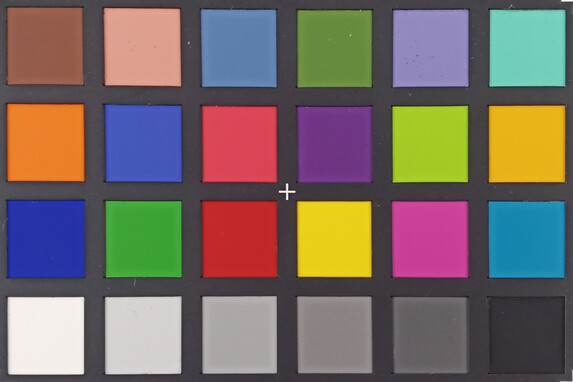

Display - IPS with little brightness reserves in the Gigaset GS4
The 6.3-inch (16.00 cm) IPS display of the Gigaset GS4 resolves with 2,340 x 1,080 pixels and thus enables a sharp display. The maximum brightness is identical with both enabled and manual modes and is also on a similar level in the APL50 measurements. The black value is okay and allows for a decent contrast ratio
The noticed display flickering is only ascertainable at minimum panel brightness and thus not quite as serious. The color reproduction is quite cool ex-factory, but those who like it more natural can adjust this in the settings. We achieved the best possible result with an adjusted white point (see screenshot), where the GS4 uses the DCI-P3 color space.
| |||||||||||||||||||||||||
Brightness Distribution: 88 %
Center on Battery: 454 cd/m²
Contrast: 908:1 (Black: 0.5 cd/m²)
ΔE ColorChecker Calman: 5.4 | ∀{0.5-29.43 Ø4.78}
ΔE Greyscale Calman: 5.5 | ∀{0.09-98 Ø5}
99.9% sRGB (Calman 2D)
Gamma: 2.11
CCT: 6763 K
| Gigaset GS4 IPS, 2340x1080, 6.3" | Wiko View5 Plus IPS, 1600x720, 6.6" | Vivo Y20s IPS, 1600x720, 6.5" | Xiaomi Redmi Note 9 IPS LCD, 2340x1080, 6.5" | |
|---|---|---|---|---|
| Response Times | 2% | -13% | 18% | |
| Response Time Grey 50% / Grey 80% * (ms) | 54.8 ? | 53.6 ? 2% | 54.4 ? 1% | 38.8 ? 29% |
| Response Time Black / White * (ms) | 27.2 ? | 26.8 ? 1% | 34.4 ? -26% | 25.6 ? 6% |
| PWM Frequency (Hz) | 602 ? | 31650 ? | ||
| Screen | 16% | 27% | 79% | |
| Brightness middle (cd/m²) | 454 | 555 22% | 502 11% | 553 22% |
| Brightness (cd/m²) | 458 | 522 14% | 468 2% | 527 15% |
| Brightness Distribution (%) | 88 | 88 0% | 87 -1% | 89 1% |
| Black Level * (cd/m²) | 0.5 | 0.35 30% | 0.41 18% | 0.12 76% |
| Contrast (:1) | 908 | 1586 75% | 1224 35% | 4608 407% |
| Colorchecker dE 2000 * | 5.4 | 6.3 -17% | 2.6 52% | 3.8 30% |
| Colorchecker dE 2000 max. * | 10.6 | 9.9 7% | 4.8 55% | 8.7 18% |
| Greyscale dE 2000 * | 5.5 | 5.5 -0% | 3.1 44% | 2.2 60% |
| Gamma | 2.11 104% | 2.22 99% | 2.37 93% | 2.3 96% |
| CCT | 6763 96% | 7909 82% | 6470 100% | 6727 97% |
| Total Average (Program / Settings) | 9% /
13% | 7% /
19% | 49% /
66% |
* ... smaller is better
Display Response Times
| ↔ Response Time Black to White | ||
|---|---|---|
| 27.2 ms ... rise ↗ and fall ↘ combined | ↗ 8.4 ms rise | |
| ↘ 18.8 ms fall | ||
| The screen shows relatively slow response rates in our tests and may be too slow for gamers. In comparison, all tested devices range from 0.1 (minimum) to 240 (maximum) ms. » 68 % of all devices are better. This means that the measured response time is worse than the average of all tested devices (20.2 ms). | ||
| ↔ Response Time 50% Grey to 80% Grey | ||
| 54.8 ms ... rise ↗ and fall ↘ combined | ↗ 26 ms rise | |
| ↘ 28.8 ms fall | ||
| The screen shows slow response rates in our tests and will be unsatisfactory for gamers. In comparison, all tested devices range from 0.165 (minimum) to 636 (maximum) ms. » 91 % of all devices are better. This means that the measured response time is worse than the average of all tested devices (31.6 ms). | ||
Screen Flickering / PWM (Pulse-Width Modulation)
| Screen flickering / PWM detected | 602 Hz | ≤ 1 % brightness setting | |
The display backlight flickers at 602 Hz (worst case, e.g., utilizing PWM) Flickering detected at a brightness setting of 1 % and below. There should be no flickering or PWM above this brightness setting. The frequency of 602 Hz is quite high, so most users sensitive to PWM should not notice any flickering. In comparison: 53 % of all tested devices do not use PWM to dim the display. If PWM was detected, an average of 8108 (minimum: 5 - maximum: 343500) Hz was measured. | |||
Performance, emissions and battery life
The Gigaset GS4 is equipped with a MediaTek Helio P70 that has 4 GB of working memory. The SoC is almost two years old, but it still delivers a good system performance. The installed eMMC storage works with a satisfactory speed for this storage type, but cannot even keep up with older UFS variants
The graphics unit can render current games in medium details smoothly for the most part. The GS4 can compensate the resulting temperatures well and does not even get warm to the touch under constant load
The mono speaker on the bottom edge can play quite loud and delivers a usable sound. However, like most speakers in smartphones, it lacks depth. The audio jack unfortunately does not meet high demands and has a quite high background noise
The 4,300 mAh strong battery enables really good battery runtimes for the Gigaset GS4. Although only a 10-watt charger is included, fast charging with up to 18 watts is supported and even wireless charging with up to 15 watts is possible
| PCMark for Android - Work 2.0 performance score (sort by value) | |
| Gigaset GS4 | |
| Wiko View5 Plus | |
| Vivo Y20s | |
| Xiaomi Redmi Note 9 | |
| Average Mediatek Helio P70 (5992 - 8365, n=12) | |
| GFXBench | |
| on screen Aztec Ruins Normal Tier Onscreen (sort by value) | |
| Gigaset GS4 | |
| Wiko View5 Plus | |
| Vivo Y20s | |
| Average Mediatek Helio P70 (6.9 - 15, n=12) | |
| Average of class Smartphone (6.2 - 166, n=209, last 2 years) | |
| 1920x1080 Aztec Ruins Normal Tier Offscreen (sort by value) | |
| Gigaset GS4 | |
| Wiko View5 Plus | |
| Vivo Y20s | |
| Average Mediatek Helio P70 (6.1 - 9.3, n=12) | |
| Average of class Smartphone (3.4 - 367, n=209, last 2 years) | |
| on screen Aztec Ruins High Tier Onscreen (sort by value) | |
| Gigaset GS4 | |
| Wiko View5 Plus | |
| Vivo Y20s | |
| Average Mediatek Helio P70 (2.6 - 8.7, n=12) | |
| Average of class Smartphone (0.85 - 144, n=210, last 2 years) | |
| 2560x1440 Aztec Ruins High Tier Offscreen (sort by value) | |
| Gigaset GS4 | |
| Wiko View5 Plus | |
| Vivo Y20s | |
| Average Mediatek Helio P70 (2.8 - 3.7, n=12) | |
| Average of class Smartphone (1.2 - 146, n=209, last 2 years) | |
| Gigaset GS4 | Wiko View5 Plus | Vivo Y20s | Xiaomi Redmi Note 9 | Average 64 GB eMMC Flash | Average of class Smartphone | |
|---|---|---|---|---|---|---|
| AndroBench 3-5 | -8% | 85% | 73% | -5% | 693% | |
| Sequential Read 256KB (MB/s) | 299.6 | 292 -3% | 504 68% | 306.6 2% | 277 ? -8% | 2228 ? 644% |
| Sequential Write 256KB (MB/s) | 245.3 | 187.2 -24% | 214.8 -12% | 248.1 1% | 178.4 ? -27% | 1852 ? 655% |
| Random Read 4KB (MB/s) | 64.8 | 72.4 12% | 141.7 119% | 65.1 0% | 60.7 ? -6% | 296 ? 357% |
| Random Write 4KB (MB/s) | 27.93 | 18 -36% | 145.7 422% | 146.9 426% | 33.8 ? 21% | 339 ? 1114% |
| Sequential Read 256KB SDCard (MB/s) | 79.1 ? | 82.9 ? 5% | 43.04 ? -46% | 84.4 ? 7% | 77.4 ? -2% | |
| Sequential Write 256KB SDCard (MB/s) | 62.2 ? | 62.2 ? 0% | 37.32 ? -40% | 63.5 ? 2% | 58.3 ? -6% |
Temperature
(+) The maximum temperature on the upper side is 33.8 °C / 93 F, compared to the average of 35.2 °C / 95 F, ranging from 21.9 to 247 °C for the class Smartphone.
(+) The bottom heats up to a maximum of 28.9 °C / 84 F, compared to the average of 34 °C / 93 F
(+) In idle usage, the average temperature for the upper side is 27.5 °C / 82 F, compared to the device average of 32.9 °C / 91 F.
Loudspeaker
Gigaset GS4 audio analysis
(+) | speakers can play relatively loud (93.5 dB)
Bass 100 - 315 Hz
(-) | nearly no bass - on average 24.9% lower than median
(+) | bass is linear (1.8% delta to prev. frequency)
Mids 400 - 2000 Hz
(±) | reduced mids - on average 6.9% lower than median
(+) | mids are linear (5.1% delta to prev. frequency)
Highs 2 - 16 kHz
(+) | balanced highs - only 2.6% away from median
(+) | highs are linear (2.8% delta to prev. frequency)
Overall 100 - 16.000 Hz
(±) | linearity of overall sound is average (15.9% difference to median)
Compared to same class
» 4% of all tested devices in this class were better, 4% similar, 91% worse
» The best had a delta of 11%, average was 35%, worst was 134%
Compared to all devices tested
» 24% of all tested devices were better, 5% similar, 71% worse
» The best had a delta of 4%, average was 24%, worst was 134%
Wiko View5 Plus audio analysis
(+) | speakers can play relatively loud (92.1 dB)
Bass 100 - 315 Hz
(-) | nearly no bass - on average 23.5% lower than median
(+) | bass is linear (4.3% delta to prev. frequency)
Mids 400 - 2000 Hz
(±) | higher mids - on average 8.8% higher than median
(+) | mids are linear (6.3% delta to prev. frequency)
Highs 2 - 16 kHz
(±) | higher highs - on average 5.7% higher than median
(+) | highs are linear (4.9% delta to prev. frequency)
Overall 100 - 16.000 Hz
(±) | linearity of overall sound is average (19.8% difference to median)
Compared to same class
» 31% of all tested devices in this class were better, 8% similar, 61% worse
» The best had a delta of 11%, average was 35%, worst was 134%
Compared to all devices tested
» 50% of all tested devices were better, 7% similar, 43% worse
» The best had a delta of 4%, average was 24%, worst was 134%
Battery life
| Gigaset GS4 4300 mAh | Wiko View5 Plus 5000 mAh | Vivo Y20s 5000 mAh | Xiaomi Redmi Note 9 5020 mAh | Average of class Smartphone | |
|---|---|---|---|---|---|
| Battery Runtime | |||||
| WiFi Websurfing (h) | 15.5 | 27.4 77% | 24.1 55% | 14.5 -6% | 19.3 ? 25% |
Pros
Cons
Verdict - Gigaset GS4 as a successful evolution
Compared with the GS290, Gigaset has improved both the performance and the price of the GS4 without compromising on quality. With the options of wireless charging and changing the battery, the smartphone is a real exotic in this price range
In general, the Bocholt company is concerned about sustainability, which is noticeable both in the packaging materials and the repairability. Gigaset also offers more than others in terms of service. The manufacturer therefore adds a three-month satisfaction guarantee to the 24-month warranty, which also includes a free repair of breakage or moisture damage within this period.
With the Gigaset GS4, the Bocholt-based company presents its strongest smartphone to date
There is a decent compromise in terms of camera technology, but it is not enough for a modern sensor like in the Poco X3, for example. Support for exFAT for the microSD slot and DRM certification are also missing. Nevertheless, Gigaset offers a competitive smartphone with the GS4
Price and availability
Gigaset's online store offers the GS4 in black and white for 229 Euros. Those who want to add an engraving (up to 26 characters) on the back can do so there directly when ordering, which costs an additional 5 Euros. The smartphone is available cheaper at Amazon, among other places
Gigaset GS4
- 01/14/2021 v7 (old)
Daniel Schmidt




